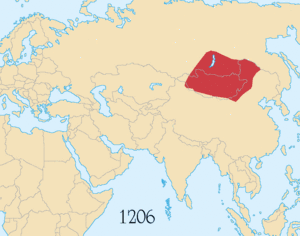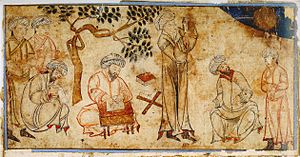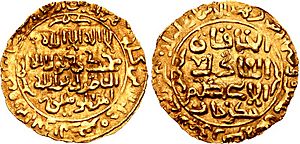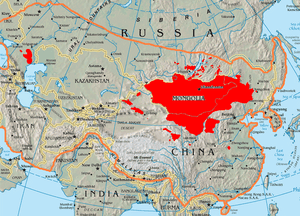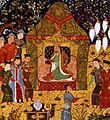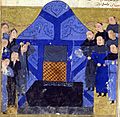Mongol Empire facts for kids
The Mongol Empire was a huge area ruled by powerful Mongol leaders called Khans during the 1200s and 1300s. It was the largest land empire in history that was all connected. The Mongols' original home was in a region surrounded by mountains and rivers, reaching from the Khingan Mountains to the Altai Mountains, and from Lake Baikal down to the Great Wall of China.
The empire was started by Genghis Khan in 1206 AD. He brought many Mongol and Turkic tribes together. By the time he died in 1227 AD, he had conquered large parts of Central Asia, North China, and eastern Persia. Later, his grandson Kublai Khan made the empire even bigger. Kublai Khan also started the Mongol-ruled Yuan Dynasty in China, ruling over the whole country. The Mongol Empire stretched from Eastern Europe all the way to Western Asia, including Central Asia and the Middle East. However, its power did not last forever. By the 1360s, the empire had split into several smaller parts, which were later destroyed.
Contents
Science and Learning in the Mongol Empire
The Mongol Empire saw many important discoveries in science. This was because the Khans often supported scientists and scholars. Some people even thought the Mongols were so successful because they were good at math!
Astronomy and Mathematics
Astronomy, the study of stars and planets, was a favorite subject of the Khans. For example, Ögedei Khan ordered repairs for an important astronomy tool called an armillary sphere. He also asked for a new calendar to be made. Möngke Khan was known for solving difficult math problems on his own. He wanted the famous astronomer Tusi to build an observatory.
Even though Möngke Khan died before his observatory was built, his brother Hulagu Khan helped Tusi build the Maragheh Observatory in Persia in 1259. This observatory was very advanced. It had about 400,000 books that Tusi had saved from cities like Baghdad. Chinese astronomers also worked there. Tusi created new astronomical tables and invented a clever mathematical tool called the Tusi couple.
Kublai Khan also built large observatories in China. His libraries had important math books, including a copy of Euclid's Elements brought by Muslim mathematicians. Famous mathematicians like Zhu Shijie and Guo Shoujing worked in Yuan China. A Mongol doctor named Hu Sihui wrote about the importance of healthy eating in 1330.
Sharing Knowledge
Later, Ghazan Khan built the Tabriz Observatory in 1295. He could understand four languages, including Latin. A Greek astronomer named Gregory Chioniades studied there. He helped bring new ideas from the Islamic world to Europe. These ideas included a special tool called an astrolabe and the Tusi couple, which later influenced Copernicus's ideas about the Earth orbiting the Sun.
The Mongol Mail System
The Mongol Empire had a very clever and fast mail system called the Yam. It had many relay stations called örtöö all across the empire. These stations were well-equipped and guarded.
How the Yam Worked
A messenger would usually ride about 25 miles (40 km) from one station to the next. At each station, they would get a fresh, rested horse or pass the mail to another rider. This made sure messages traveled as fast as possible. Mongol riders could cover about 125 miles (200 km) in a single day! This was much faster than the Pony Express system, which came 600 years later.
The relay stations also had homes nearby to support them. Anyone with a special pass called a paiza could use these stations for new horses and food. Even military messengers could use the Yam without a paiza. Many merchants, messengers, and travelers from China, the Middle East, and Europe used this system. For example, when the Great Khan died in Karakorum, news reached Mongol armies in Central Europe within 4 to 6 weeks because of the Yam.
Roads and Expansion
Genghis Khan and his successor Ögedei Khan built a wide network of roads. One of these roads went through the Altai Mountains. After Ögedei became Khan, he made the road system even bigger, connecting roads in the western parts of the empire.
Kublai Khan, who founded the Yuan dynasty, built special relays for important officials. During his rule, the Yuan communication system had about 1,400 postal stations. These stations used many animals and vehicles, including 50,000 horses and 6,000 boats.
In some colder regions like Manchuria and southern Siberia, the Mongols even used dogsled teams for the Yam. Later, in the Ilkhanate (a part of the Mongol Empire), Ghazan Khan improved the mail system again. He built some hostels and said that only imperial messengers could get special support.
The Silk Road and Trade
The Mongols were known for supporting merchants and trade. Even before he united the Mongols, Genghis Khan encouraged foreign merchants. Merchants were important because they brought information about other cultures. They also served as diplomats and official traders, and they supplied many goods that the Mongols did not produce themselves.
Mongol Support for Merchants
The Mongol government and wealthy Mongols often gave money to merchants. They sent them on long journeys in a special business arrangement called an ortoq. This was similar to other business partnerships of the time. Mongol leaders also formed trade partnerships with merchants from Italian cities, including the family of Marco Polo.
As the empire grew, any merchants or ambassadors with the right documents were protected as they traveled through Mongol lands. Well-maintained roads connected lands from the Mediterranean Sea all the way to China. This greatly increased trade by land, leading to amazing stories from those who traveled along what became known as the Silk Road.
Famous Travelers
The famous Western explorer Marco Polo traveled east along the Silk Road. A Chinese Mongol monk named Rabban Bar Sauma made a similarly long journey, traveling from his home in Khanbaliq (modern-day Beijing) all the way to Europe. European missionaries, like William of Rubruck, also traveled to the Mongol court. They hoped to convert people or to deliver messages from the Pope, trying to form an alliance with the Mongols.
It was rare for anyone to travel the entire length of the Silk Road. Instead, goods were traded from one middleman to another, like a bucket brigade. This meant that goods from China could reach the West, but they would become very expensive along the way.
After Genghis Khan, the merchant business continued to do well under his successors, Ögedei and Güyük. Merchants brought clothing, food, and other supplies to the imperial palaces. In return, the Great Khans gave merchants tax breaks and allowed them to use the official Mongol mail stations. Merchants also helped collect taxes in China, Russia, and Iran. If merchants were attacked by bandits, any losses were paid back from the imperial treasury.
Changes in Policy
Policies changed under Möngke Khan. Because some merchants were misusing the system or overtaxing people, he tried to stop these problems. He sent special investigators to watch the ortoq businesses. He also ordered that all merchants must pay business and property taxes. This policy continued under the Yuan dynasty.
The fall of the Mongol Empire in the 1300s led to a breakdown of the connections along the Silk Road. In the west, Turkic tribes took over parts of the route, which eventually led to the rise of the Ottoman Empire. In the east, the Chinese overthrew the Yuan dynasty in 1368 and started the Ming dynasty. The Ming dynasty then focused more on keeping China separate from other countries.
Legacy of the Mongol Empire
The Mongol Empire, being the largest connected empire in history, had a lasting impact. It brought together huge regions, some of which (like parts of Russia and western China) are still united today. After the empire fell, many Mongols blended into the local populations. Some of their descendants adopted local religions. For example, the eastern Mongols mostly became Buddhists, while the western Mongols largely adopted Islam.
Impact on Populations
Some historians believe that Genghis Khan's conquests caused a lot of destruction in certain areas. This led to big changes in the populations of Asia. For instance, the population of China dropped significantly during 50 years of Mongol rule. Before the Mongol invasion, China had about 120 million people. After the conquest, a census in 1300 reported about 60 million. Historians have different ideas about why this happened. Some think it was due to problems with record-keeping, while others believe the Mongols caused a real decline in population. The Black Death (a terrible disease) also played a big role in population decline in China and other parts of the world.
The Islamic world also experienced huge changes because of the Mongol invasions. The population of the Iranian plateau suffered from widespread disease and famine. Some historians estimate that Iran's population did not return to its pre-Mongol levels until the mid-1900s. Mesopotamia, a region known for its ancient civilizations, also saw a large decrease in its population and importance.
Other Lasting Effects
Here are some other long-term effects of the Mongol Empire:
- Rise of Moscow: Moscow became an important city while it was under Mongol-Tatar rule. Russian rulers collected taxes for the Mongols, which meant the Mongols rarely visited these lands. Eventually, the Russians gained military strength. Their ruler Ivan III finally overthrew the Mongols and formed the Russian Tsardom.
- Expanded World Knowledge: Europeans learned much more about the world thanks to information brought back by Mongol ambassadors and merchants. When Christopher Columbus sailed in 1492, he hoped to reach "Cathay" (China) and deliver a letter to the Grand Khan.
- The Black Death: Some studies suggest that the Black Death, which devastated Europe in the late 1340s, may have spread from China to Europe along the Mongol trade routes. This terrible disease caused millions of deaths worldwide.
- Writing System: The Mongols introduced a writing system for their language, based on the Old Uyghur alphabet. This alphabet is still used in Mongolia today.
Images for kids
See also
 In Spanish: Imperio mongol para niños
In Spanish: Imperio mongol para niños


